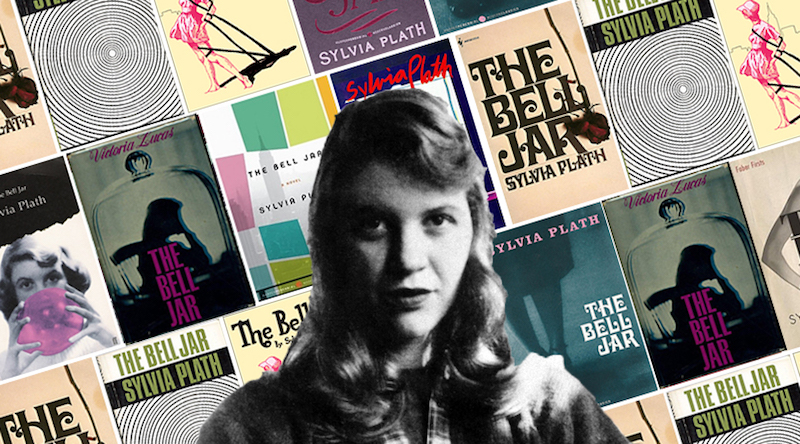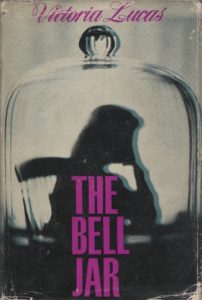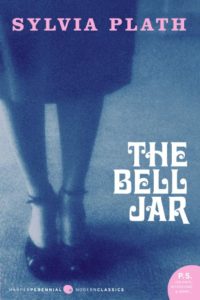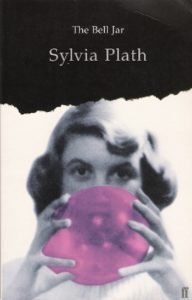
Today marks fifty-six years since the first publication of Sylvia Plath’s only novel. A haunted semi-autobiographical tale of a young woman’s spiral into depression and mental illness during a summer interning at a prominent magazine in New York City, The Bell Jar was originally published in Britain under Plath’s pseudonym, Victoria Lucas, before being rereleased under the poet’s own name in 1967. Plath, however, never got to witness the seismic impact her novel, as well as her now-iconic poetry collection Ariel (1965), would go on to have. She took her own life on February 11, less than a month after The Bell Jar first hit shelves.
Though often considered a lesser work than her poetry collections, in the years since Plath’s death The Bell Jar has become a totemic novel for teenage girls and young women around the world. Despite initially being rejected by American publishers (who complained that it lacked plot and cohesion), the book has now sold over 3 million copies in the US and is a staple of high school english classes countrywide.
By the time The Bell Jar finally finally reached American readers in 1971, it was impossible for critics to consider the novel outside of the context of Plath’s suicide and the mythos which had been built up around her tragically short life in the years that followed. This made for some particularly interesting, albeit loaded, criticism.
Below, we look at four of the most intriguing reviews from that year.
*

The trouble was, I had been inadequate all along, I simply hadn’t thought about it.
“The Bell Jar is a novel about the events of Sylvia Plath’s 20th year: about how she tried to die, and how they stuck her together with glue. It is a fine novel, as bitter and remorseless as her last poems—the kind of book Salinger’s Franny might have written about herself 10 years later, if she had spent those 10 years in Hell. It is very much a story of the fifties, but written in the early sixties, and now, after being effectively suppressed in this country for eight years, published in the seventies.
F. Scott Fitzgerald used to claim that he wrote with ‘the authority of failure,’ and he did. It was a source of power in his later work. But the authority of failure is but a pale shadow of the authority of suicide, as we feel it in Ariel and in The Bell Jar. This is not so much because Sylvia Plath, in taking her own life, gave her readers a certain ghoulish interest they could not bring to most poems and novels, though this is no doubt partly true. It is because she knew that she was ‘Lady Lazarus.’ Her works do not only come to us posthumously. They were written posthumously. Between suicides. She wrote her novel and her Ariel poems feverishly, like a person ‘stuck together with glue’ and aware that the glue was melting. Should we be grateful for such things? Can we accept the price she paid for what she has given us? Is dying really an art?
There are no easy answers for such questions, maybe no answers at all. We are all dying, of course, banker and bum alike, spending our limited allotment of days, hours and minutes at the same rate. But we don’t like to think about it. And those men and women who take the matter into their own hands, and spend all at once with prodigal disdain, seem frighteningly different from you and me. Sylvia Plath is one of those others, and to them our gratitude and our dismay are equally impertinent. When an oracle speaks it is not for us to say thanks but to attend to the message.
…
“…this personal life is delicately related to larger events–especially the execution of the Rosenbergs, whose impending death by electrocution is introduced in the stunning first paragraph of the book. Ironically, that same electrical power which destroys the Rosenbergs, restores Esther to life. It is shock therapy which finally lifts the bell jar and enables Esther to breathe freely once again. Passing through death she is reborn. This novel is not political or historical in any narrow sense, but in looking at the madness of the world and the world of madness it forces us to consider the great question posed by all truly realistic fiction: What is reality and how can it be confronted?
In The Bell Jar, Sylvia Plath has used superbly the most important technical device of realism—what the Russian critic Shklovsky called ‘defamiliarization.’ True realism defamiliarizes our world so that it emerges from the dust of habitual acceptance and becomes visible once again. This is quite the opposite of that comforting false realism that presents the world in terms of clichès that we are all too ready to accept.
…
“Esther Greenwood’s account of her year in the bell jar is as clear and readable as it is witty and disturbing. It makes for a novel such as Dorothy Parker might have written if she had not belonged to a generation infected with the relentless frivolity of the college humor magazine. The brittle humor of that early generation is reincarnated in The Bell Jar, but raised to a more serious level because it is recognized as a resource of hysteria. Why, then, has this extraordinary work not appeared in the United States until eight years after its appearance in England?”
–Robert Scholes, The New York Times, April 11, 1971

I took a deep breath and listened to the old brag of my heart. I am, I am, I am.
“The novel itself is no firebrand. It’s a slight, charming, sometimes funny and mildly witty, at moments tolerably harrowing ‘first’ novel, just the sort of clever book a Smith summa cum laude (which she was) might have written if she weren’t given to literary airs. From the beginning our expectations of scandal and startling revelation are disappointed by a modesty of scale and ambition and a jaunty temperateness of tone. The voice is straight out of the 1950’s: politely disenchanted, wholesome, yes, wholesome, but never cloying, immediately attractive, nicely confused by it all, incorrigibly truthtelling; in short, the kind of kid we liked then, the best product of our best schools. The hand of Salinger lay heavy on her.
But this is 1971 and we read her analyst, too wily to be deceived by that decent, smiling, well-scrubbed coed who so wants to be liked and admired. We look for the slips and wait for the voice to crack. We want the bad, the worst news; that’s what we’re here for, to be made happy by horror, not to be amused by girlish chatter. Our interests are clinical and prurient, A hard case, she confounds us. She never raises her voice. To control it, she stays very close to the line of her life in her twentieth year, telling rather than evoking the memorable events; more bemused than aghast.
…
“What should have been exciting—she was a small-town girl living in NYC for the first time on her own—was dreary, trivial, flat. She was beginning to doubt herself, her talent, her prospects. Mysteriously, as if from another work, period of life, region of the mind, images and memories startlingly appear, and just as quickly vanish; colors and events we recognize from the late poems: darkness and blackness; the world perceived as misshapen and ominous; her father (the figure of her marvelous poem ‘Daddy’) remembered with love and fury, the source of her last ‘pure’ happiness at the age of nine before he perversely left her bereft one day by cruelly dying; foetuses and blood, fever and sickness, the obsession with purity and the grotesque burden of her body, of feeling itself. In the poems the pressure is terrific; she screams her pain, in a final effort to contain it; yet here it is duly noted, set down serially, linearly, as possibly interesting to those in the business of making connections, scrupulously recorded as in a printed clinical questionnaire by a straight-A girl in the habit of carefully completing forms.
…
“She laid out the elements of her life, one after the other, and left to the late poems the necessary work of imagining and creating it: it is for this reason that we feel in the book an absence of weight and complexity sufficient to the subject.
On balance, The Bell Jar, good as it is, must be counted part of Sylvia Plath’s juvenilia, along with most of the poems of her first volume; though in the novel as in a few of the early poems she foretells the last voice she was ever to command.”
–Saul Maloff, The New Republic, May 8, 1971

There is nothing like puking with somebody to make you into old friends.
“For reasons for which we are not wholly to blame, our approach to the novel is impure; The Bell Jar is fiction that cannot escape being read in part as autobiography … A plain recital of the events in The Bell Jar would be ludicrous if they were not balanced by genuine desperation at one side of the scale and a sure sense of black comedy at the other. Sickness and disclosure are the keys to The Bell Jar.
…
“The casualness with which physical suffering is treated suggests that Esther is cut off from the instinct for sympathy right from the beginning—for herself as well as for others. Though she is enormously aware of the impingements of sensation, her sensations remain impingements. She lives close to the nerve, but the nerve has become detached from the general network. A thin layer of glass separates her from everyone, and the novel’s title, itself made of glass, is evolved from her notion of disconnection: the head of each mentally ill person is enclosed in a bell jar, choking on his own foul air … one of the great achievements of The Bell Jar is that it makes real the subtle distinctions between a distorted viewpoint and the distortions inherent in what it sees. Convention may contribute to Esther’s insanity, but she never loses her awareness of the irrationality of convention.
…
“The Bell Jar lacks the coruscating magnificence of the late poems. Something girlish in its manner betrays the hand of the amateur novelist. Its material, after all, is what has been transcended. It is a frightening book, and if it ends on too optimistic a note as both fiction and postdated fact, its real terror lies elsewhere. Though we share every shade of feeling that leads to Esther’s attempts at suicide, there is not the slightest insight in The Bell Jar into suicide itself. That may be why it bears the stamp of authority. Reading it, we are up against the raw experience of nightmare, not the analysis or understanding of it.”
–Howard Moss, The New Yorker, July 10, 1971

To the person in the bell jar, blank and stopped as a dead baby, the world itself is a bad dream.
“It is not recklessness that makes Sylvia Plath so forbidding, but destructiveness toward herself and others. Her mother thought The Bell Jar represented ‘the basest ingratitude’ and we can only wonder at her innocence in expecting anything else. For the girl in the novel, a true account of events so far as we know, the ego is disintegrating and the stifling self-enclosure is so extreme that only death—and after that fails, shock treatment—can bring any kind of relief. Persons suffering in this way simply do not have room in their heads for the anguish of others—and later many seem to survive their own torments only by an erasing detachment. But even in recollection—and The Bell Jar was written a decade after the happenings—Sylvia Plath does not ask the cost.
There is a taint of paranoia in her novel and also in her poetry. The person who comes through is merciless and threatening, locked in violent images. If she does not, as so many have noticed, seem to feel pity for herself, neither is she moved to self-criticism or even self-analysis. It is a sour world, a drifting, humid air of vengeance. The Bell Jarseems to be a realistic account of her suicide attempt during the summer before her senior year at Smith. But the novel is about madness as well, and that separates it from the poems. Death, in the poetry, is an action, a possibility, a gesture, complete in itself, unmotivated, unexamined.
…
“The novel is not equal to the poems, but it is free of gross defects and embarrassments. The ultimate effort was not made, perhaps, but it is limited more in its intentions than in the rendering. The book has an interestingly cold, unfriendly humor. We sympathize with the heroine because of her drudging facing of it all and because of her suffering. The suffering is described more or less empirically, as if it were a natural thing, and the pity flows over you partly because she herself is so hard and glassy about her life.
This autobiographical work is written in a bare, rather collegiate 1950s style, and yet the attitude, the distance and bitter carelessness are colored by a deep mood of affectlessness. The pleasures and sentiments of youth—wanting to be invited to the Yale prom, losing your virginity—are rather unreal in a scenario of disintegration, anger, and a perverse love of the horrible. The seduction of Esther Greenwood, as the heroine is called, is memorably grotesque and somehow bleakly suitable. The act led to a dangerous, lengthy, very unusual hemorrhaging. The blood—an obsession with the author—flows so plentifully that the girl is forced to seek medical help. She rather grimly pursues the young man with demands that he pay the doctor’s bill, as if in some measure to get revenge for an action she herself cooperated with in the interest of experience.
The atrocious themes, the self-enclosure, the pain, blood, fury, infatuation with the hideous—all of that is in The Bell Jar. But, in a sense, softly, hesitantly. The poems in Ariel are much more violent. Indeed, the celebrated poem ‘Daddy’ is as mean a portrait as one can find in literature.”
–Elizabeth Hardwick, The New York Review of Books, August 12, 1971

